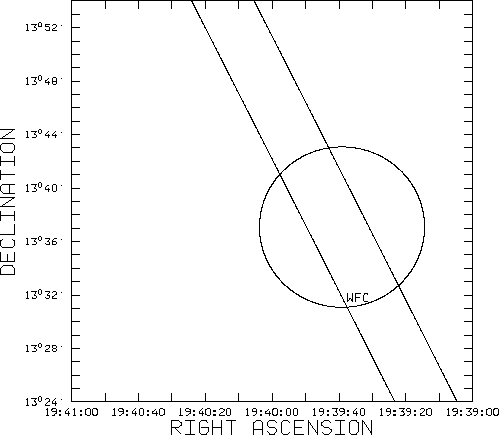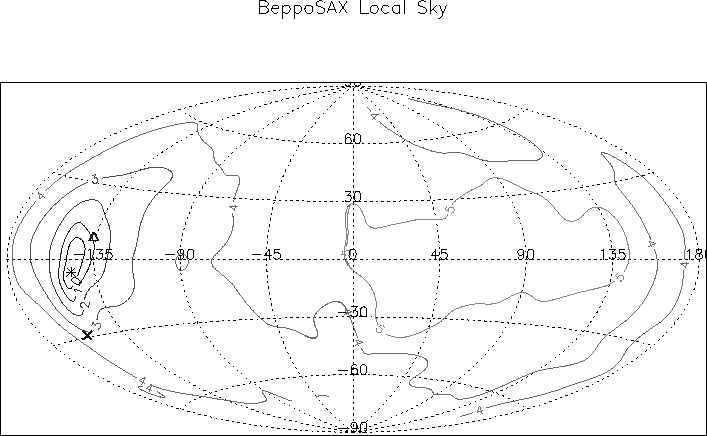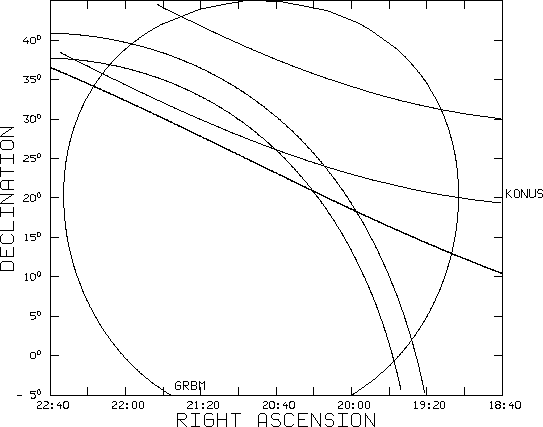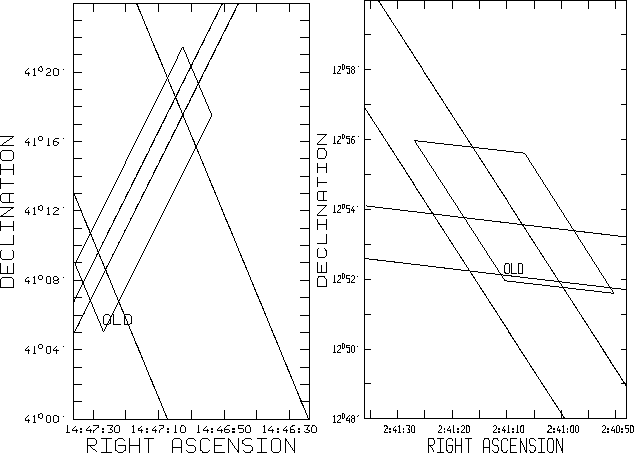



Next: Faint WFC Bursts
Up: The GRBM in the
Previous: The GRBM in the
Contents
For the limits already discussed in section 1.3.2, the IPN needs
light curves with high time resolutions (at least  few
few  ms):
in the case of the GRBM,
the light curve is rebinned to
ms):
in the case of the GRBM,
the light curve is rebinned to  ms from the original
ms from the original  ms;
an example of a GRBM light curve used for an IPN triangulation
is shown in fig.
ms;
an example of a GRBM light curve used for an IPN triangulation
is shown in fig. ![[*]](crossref.png) .
In this case, the burst position,
previously measured by the WFC1 (GCN 1033, 1035), was refined with
an IPN triangulation between Ulysses and the GRBM (GCN 1036),
by crossing the IPN annulus with the WFC region: the intersection
region area was
.
In this case, the burst position,
previously measured by the WFC1 (GCN 1033, 1035), was refined with
an IPN triangulation between Ulysses and the GRBM (GCN 1036),
by crossing the IPN annulus with the WFC region: the intersection
region area was  square arcmin, from the initial
square arcmin, from the initial
 radius circle of the refined WFC position (GCN 1035;
see fig.
radius circle of the refined WFC position (GCN 1035;
see fig. ![[*]](crossref.png) ).
).
Figure:
The Ulysses-BeppoSAX annulus intersects the WFC error
circle of GRB010412 (courtesy of K. Hurley).
 |
This burst shows a highly featured light curve, with a dramatic
time variability on few ms timescales: these sharp temporal
structures strongly constrain the cross-check between light curves
of the same event from different experiments, limiting the width
of the IPN annulus.
In Table ![[*]](crossref.png) I list the GRBs that have been localized
thanks to IPN localizations including the GRBM as one of the IPN nodes.
Since the start of the on-line GRB quest, the IPN with GRBM localized
18 bursts: in some cases, the IPN position followed a previous one,
obtained by the WFC/BeppoSAX (GRB000529, GRB000620, GRB010412 and GRB011121),
by ASM/Rossi-XTE (GRB010324) and by HETE-II (GRB010612,GRB010629 and
GRB010921); two bursts were also detected by BATSE/CGRO (GRB000429
and GRB000519).
I list the GRBs that have been localized
thanks to IPN localizations including the GRBM as one of the IPN nodes.
Since the start of the on-line GRB quest, the IPN with GRBM localized
18 bursts: in some cases, the IPN position followed a previous one,
obtained by the WFC/BeppoSAX (GRB000529, GRB000620, GRB010412 and GRB011121),
by ASM/Rossi-XTE (GRB010324) and by HETE-II (GRB010612,GRB010629 and
GRB010921); two bursts were also detected by BATSE/CGRO (GRB000429
and GRB000519).
Figure:
GRB010923: the triangle spots the IPN position
(
 ,
,
 ) while the
asterisk denotes the GRBM position centroid
(
) while the
asterisk denotes the GRBM position centroid
(
 ,
,
 )
and the cross corresponds to the 2nd, wrong IPN solution
(
)
and the cross corresponds to the 2nd, wrong IPN solution
(
 ,
,
 )
: the GRBM position allowed to resolve the IPN ambiguity.
)
: the GRBM position allowed to resolve the IPN ambiguity.
 |
Eventually, the case of GRB010923 is particularly
important for the localization capabilities of the GRBM: actually,
the triangulation for this burst, made with Ulysses, Konus/WIND
and GRBM/BeppoSAX data, gave two positions: then, the right one was
determined thanks to the GRBM estimate (fig. ![[*]](crossref.png) );
in fig.
);
in fig. ![[*]](crossref.png) the IPN triangulation derived for this
burst is shown: here the GRBM error circle is an approximation
of the 90% CL region come out from GRBM localization shown in
fig.
the IPN triangulation derived for this
burst is shown: here the GRBM error circle is an approximation
of the 90% CL region come out from GRBM localization shown in
fig. ![[*]](crossref.png) .
.
Figure:
GRB010923: the IPN triangulation redundancy is
resolved by means of the GRBM error circle, as it includes
only one of the two possible intersection regions (courtesy of K. Hurley).
 |
Other two nice GRBs that were localized by means of IPN triangulations
are GRB000630 (GCN 736) and GRB001204 (GCN 895): both were
detected by four experiments (Ulysses, GRBM/BeppoSAX, Konus/WIND and
NEAR), thus giving two independent annuli, whose ambiguity has been
resolved by the forth spacecraft (fig. ![[*]](crossref.png) ).
The localization of GRB000630 allowed the discovery of its optical
afterglow (GCN 747); even if no afterglow candidate was found in the
case of the short duration GRB001204 (
).
The localization of GRB000630 allowed the discovery of its optical
afterglow (GCN 747); even if no afterglow candidate was found in the
case of the short duration GRB001204 (
 s,
as estimated from the GRBM data), it has been possible to give upper
limits on possible afterglows ([Hurley et al., 2001]).
s,
as estimated from the GRBM data), it has been possible to give upper
limits on possible afterglows ([Hurley et al., 2001]).
Figure:
Examples of localization of two IPN bursts: both GRB000630
(left panel) and GRB001204 (right panel) were detected by Ulysses,
BeppoSAX/GRBM, Konus/WIND and NEAR. In both cases,
the two IPN annuli, crossing each other, are shown.
Only for the first an afterglow was found (optical band);
GRB001204 was a short duration burst (courtesy of K. Hurley).
 |
Table:
18 IPN GRBs with GRBM contribution (Apr. 2000 - Dec. 2001)
| GRB Date |
UT |
R.A. |
Decl. |
Err. |
Experiments |
GCN |
| |
( ) ) |
( ) ) |
( ) ) |
(
 ) ) |
 |
# |
| 19 Apr 2000 |
02:12:49 |
330.07 |
48.28 |
18 |
U+BS+KW+N |
641 |
| 29 Apr 2000 |
10:07:22 |
98.34 |
-4.42 |
12 |
U+BS+BA+KW+N |
657 |
| 16 May 2000 |
09:26:05 |
35.07 |
-14.83 |
30 |
U+BS+KW+N |
671 |
| 19 May 2000 |
08:18:13 |
346.16 |
1.17 |
18 |
U+BS+BA+N |
672 |
| 29 May 2000 |
08:43:12 |
2.28 |
-61.53 |
6 |
WFC +BS+KW+N +BS+KW+N |
678 |
| 15 Jun 2000 |
16:32:35 |
35.61 |
-17.87 |
12 |
U+BS+KW+N |
710 |
| 20 Jun 2000 |
05:33:33 |
113.82 |
69.20 |
6 |
WFC +U+BS+KW +U+BS+KW |
723 |
| 30 Jun 2000 |
00:30:53 |
221.81 |
41.22 |
24 |
U+BS+KW+N |
736 |
| 04 Oct 2000 |
14:51:27 |
240.09 |
-56.81 |
360 20 20 |
U+BS+N |
835 |
| 04 Dec 2000 |
08:01:09 |
40.29 |
12.90 |
12 |
U+BS+KW+N |
895 |
| 12 Dec 2000 |
14:57:23 |
102.40 |
36.44 |
6 |
U+BS+KW+N |
899 |
| 24 Mar 2001 |
11:37:32 |
107.78 |
20.08 |
15 |
ASM +U+BS +U+BS |
1011 |
| 12 Apr 2001 |
21:46:29 |
290.91 |
13.62 |
6 |
WFC +U+BS +U+BS |
1033,1035,1036 |
| 12 Jun 2001 |
02:33:13 |
270.82 |
-32.13 |
60 |
HETE +U+BS+KW +U+BS+KW |
1065 |
| 29 Jun 2001 |
12:21:07 |
248.16 |
-18.72 |
15 |
HETE +U+BS +U+BS |
1076 |
| 21 Sep 2001 |
05:15:50 |
343.90 |
40.93 |
18 |
HETE +U+BS +U+BS |
1096, 1097 |
| 23 Sep 2001 |
09:24:30 |
302.07 |
18.03 |
18 |
U+BS+KW+GRBM |
1104 + (a) |
| 21 Nov 2001 |
18:47:11 |
173.63 |
-76.03 |
3 |
WFC +U+BS +U+BS |
1148 |

- U=Ulysses, BS=BeppoSAX (GRBM), KW=Konus/WIND, N=NEAR, BA=BATSE.

- Burst previously localized by the WFC/BeppoSAX.

- Burst previously localized by the ASM/RXTE (GCN/RXTE, BACODINE).

- Burst previously localized by the HETE-II.

- In this case, the GRBM contributes twice: first,
as a member of the IPN, and second, because its rough position allowed to
solve the usual IPN ambiguity of two distant solutions
(whenever the number of spacecrafts is
 ).
).
- (
 )
)
- GRBM trigger time.
- (a)
- K. Hurley, private comm.




Next: Faint WFC Bursts
Up: The GRBM in the
Previous: The GRBM in the
Contents
Cristiano Guidorzi
2003-07-31

![[*]](crossref.png) .
In this case, the burst position,
previously measured by the WFC1 (GCN 1033, 1035), was refined with
an IPN triangulation between Ulysses and the GRBM (GCN 1036),
by crossing the IPN annulus with the WFC region: the intersection
region area was
.
In this case, the burst position,
previously measured by the WFC1 (GCN 1033, 1035), was refined with
an IPN triangulation between Ulysses and the GRBM (GCN 1036),
by crossing the IPN annulus with the WFC region: the intersection
region area was ![[*]](crossref.png) ).
).

![[*]](crossref.png) I list the GRBs that have been localized
thanks to IPN localizations including the GRBM as one of the IPN nodes.
Since the start of the on-line GRB quest, the IPN with GRBM localized
18 bursts: in some cases, the IPN position followed a previous one,
obtained by the WFC/BeppoSAX (GRB000529, GRB000620, GRB010412 and GRB011121),
by ASM/Rossi-XTE (GRB010324) and by HETE-II (GRB010612,GRB010629 and
GRB010921); two bursts were also detected by BATSE/CGRO (GRB000429
and GRB000519).
I list the GRBs that have been localized
thanks to IPN localizations including the GRBM as one of the IPN nodes.
Since the start of the on-line GRB quest, the IPN with GRBM localized
18 bursts: in some cases, the IPN position followed a previous one,
obtained by the WFC/BeppoSAX (GRB000529, GRB000620, GRB010412 and GRB011121),
by ASM/Rossi-XTE (GRB010324) and by HETE-II (GRB010612,GRB010629 and
GRB010921); two bursts were also detected by BATSE/CGRO (GRB000429
and GRB000519).

![[*]](crossref.png) );
in fig.
);
in fig. ![[*]](crossref.png) the IPN triangulation derived for this
burst is shown: here the GRBM error circle is an approximation
of the 90% CL region come out from GRBM localization shown in
fig.
the IPN triangulation derived for this
burst is shown: here the GRBM error circle is an approximation
of the 90% CL region come out from GRBM localization shown in
fig. ![[*]](crossref.png) .
.

![[*]](crossref.png) ).
The localization of GRB000630 allowed the discovery of its optical
afterglow (GCN 747); even if no afterglow candidate was found in the
case of the short duration GRB001204 (
).
The localization of GRB000630 allowed the discovery of its optical
afterglow (GCN 747); even if no afterglow candidate was found in the
case of the short duration GRB001204 (
